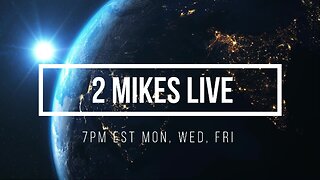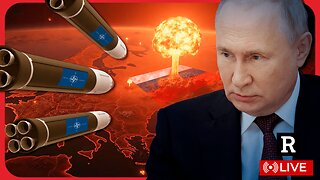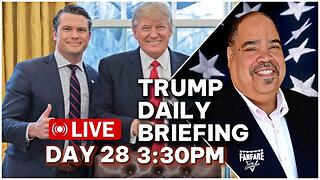Premium Only Content

Episode 2752: A New New Theology and the Future of the Mass
A New, New Theology and the Future of the Mass
Let us begin with a prayer to St. Pius V, defender of the Mass of the Ages:
"O glorious St. Pius V, protector of the Holy Mass and champion of Sacred Tradition, intercede for us in these times of trial. Grant us the grace to remain steadfast in the faith and to uphold the treasures of the Church, unshaken by the winds of change. Through Christ our Lord. Amen."
Today’s topic is as urgent as it is controversial: the "new, new theology" proposed under Pope Francis, its implications for the Church’s ecclesiology, and how it threatens the sacredness of the Mass.
We will explore the roots of these changes, the rumored introduction of a "Mass without Consecration," the Mayan Rite controversy, and what all of this means for the faithful. Along the way, we’ll revisit the insights of Father Malachi Martin, Church history, and the undeniable wisdom of St. Pius V.
Now I know many of you will say “Please Walt no more negativity and please move on”. We must never become indifferent to what Satan through his minions especially within the Church want to do to destroy the mystical body of Christ. Quite honestly if you do not stand up, you by your indifference contribute to the error. You must pay attention and you must speak out.
Segment 1: What is the “New, New Theology”?
Recently, Pope Francis called for a new theology of synodality to complement the synodal vision of the Church. Modernist theologians like Cardinal Hollerich and Cardinal Roche have echoed this call, asserting that the Traditional Latin Mass (TLM) no longer fits with the "ecclesiology" of the post-Vatican II Church. This claim fundamentally challenges the organic development of the Roman Rite, which traces its roots to the Apostles.
But what does this "new, new theology" entail? Its advocates envision a Church no longer bound by the immutability of sacred tradition but one that conforms to the ever-changing cultures of the world. This is why, as Cardinal Roche stated, the TLM must be suppressed it stands as a living testament to the unchanging truths of the Catholic faith.
This modernist view misrepresents the faith handed down to us, dismissing the organic development of the TLM and asserting that it was merely a construct of the 16th century. However, as any serious scholar of liturgy knows, the Roman Rite is the fruit of centuries of faithful preservation, formalized not invented by Pope St. Gregory the Great and later refined by St. Pius V.
Now lets stop right here because this is what modernist liberals do very well. They use false sound bite’s and everyone bites those falsehoods and simply parrots them. Lets provide the truth which is always the best disinfectant.
The claim that the Traditional Latin Mass (TLM) was “invented” by Pope St. Pius V in 1570 is a misrepresentation often perpetuated by modernist circles to undermine the antiquity and sacredness of the TLM. This assertion is historically and theologically inaccurate and ignores the organic development of the liturgy over centuries. Let’s break this down with facts and historical context.
The Historical Development of the Traditional Latin Mass
1. Roots in Apostolic Tradition:
The liturgy of the Church traces its roots to the practices of the Apostles. The early Christians celebrated the Eucharist in a manner resembling the Last Supper, incorporating prayers, scripture readings, and the breaking of bread. By the 2nd century, St. Justin Martyr's writings describe a liturgy that mirrors the essential elements of the Mass today.
2. The Role of Pope St. Gregory the Great (590-604 AD):
Pope St. Gregory the Great played a pivotal role in shaping the Roman Rite. He streamlined and codified the prayers and chants of the Mass, organizing what became known as the Gregorian Sacramentary. His reforms established the Roman Canon (the Eucharistic Prayer), which has remained largely unchanged for over 1,400 years. Gregory’s contributions were not an "invention" but a refinement of existing liturgical practices, emphasizing the continuity of tradition.
3. The Council of Trent and Pope St. Pius V (1570):
In the aftermath of the Protestant Reformation, the Council of Trent (1545–1563) sought to address the liturgical chaos caused by various Protestant innovations. Pope St. Pius V responded by standardizing the Roman Rite through the bull Quo Primum in 1570. However, this was not a new invention; it was a unification of the liturgy based on the Missal of the Roman Church as it had been celebrated for centuries.
o Retention of Antiquity: The Missal of St. Pius V preserved the essential structure and prayers of the Mass, which had developed organically over more than a millennium. His work was to codify and safeguard the liturgy from further innovation, not to create a new form of worship.
4. Organic Development Over Centuries:
The liturgical practices of the Latin Church evolved naturally, guided by the Holy Spirit and in response to the needs of the faithful. Key elements, such as the use of Latin, Gregorian chant, and the reverence of the Eucharistic sacrifice, became hallmarks of the Traditional Latin Mass. These elements were not imposed by a single pope or council but were cultivated over time.
________________________________________
The Modernist Narrative and Its Errors
1. Modernist Claim:
The assertion that the TLM was "invented" by St. Pius V is a deliberate oversimplification. Modernists aim to diminish the TLM’s continuity with Apostolic tradition, suggesting that liturgical practices are mutable and subject to the whims of committees.
2. Contrast with the Novus Ordo Missae (1969):
The Novus Ordo Missae, promulgated by Pope Paul VI after Vatican II, was indeed crafted by a committee, led by Archbishop Annibale Bugnini. This liturgy introduced substantial changes, including alterations to the Eucharistic prayers, the inclusion of vernacular languages, and a shift in focus from the sacrificial nature of the Mass to a more communal meal-oriented theology. Critics argue that these changes were not organic but represented a rupture with liturgical tradition.
3. The Mayan Rite of Mass
The introduction of new rites, such as the Mayan Rite, further exemplifies the modernist tendency to treat liturgy as a cultural product rather than a sacred and universal act of worship. Proponents of these innovations often dismiss the TLM’s history to justify their departures from established practices.
________________________________________
Defense of the Traditional Latin Mass
1. Continuity with Tradition:
The TLM embodies the Church’s living tradition. It connects modern Catholics with the faith of their ancestors, reflecting the Church’s understanding of the Mass as a re-presentation of Christ’s sacrifice on Calvary.
2. Testimony of Saints:
Many saints, including St. Thomas Aquinas, St. Francis of Assisi, and St. Padre Pio, celebrated or revered the Traditional Latin Mass. Their lives attest to its sanctity and spiritual efficacy.
3. Historical Evidence:
Liturgical manuscripts and archaeological findings confirm that key elements of the TLM, such as the use of Latin, the Roman Canon, and reverence for the Eucharist, predate Pope St. Pius V by centuries.
4. Papal Authority and Protection:
Quo Primum not only codified the Roman Missal but also granted it a unique protection, stating that it should remain unchanged. While later minor revisions were made, the core of the TLM remained consistent, underscoring its timeless nature.
________________________________________
The Danger of Misrepresentation
By claiming that the TLM lacks historical depth, modernists seek to undermine its legitimacy and pave the way for continuous liturgical experimentation. This misrepresentation erodes the faithful’s understanding of the Mass as a sacred tradition handed down through the Apostles. Defending the TLM requires clarity about its origins, development, and role in preserving the Catholic faith.
The TLM is not an invention of St. Pius V but the fruit of centuries of liturgical growth under the guidance of the Holy Spirit. It stands as a testament to the Church’s commitment to honoring and preserving the sacred traditions entrusted to her by Christ and the Apostles.
Segment 2: The Rumor of a "Mass Without Consecration"
For decades, there have been whispers of a new "Simple Rite," a Mass designed to appease Protestant sensibilities by removing the consecration of the Eucharist. Fr. Malachi Martin warned of this possibility, describing it as a tactic to dilute the faith in favor of ecumenical unity at the expense of the true presence of Christ in the Eucharist.
If such a Mass were introduced, it would not be a Mass at all. Without the consecration, there is no Eucharist, no Real Presence, and no Sacrifice. To attend such a liturgy would be to reject the heart of the Catholic faith. The sacred mysteries cannot be compromised to accommodate the sensibilities of those outside the Church.
The idea of a "Mass without Consecration," sometimes referred to as a "Simple Rite," is a troubling concept often discussed in traditional Catholic circles as a hypothetical future development. Fr. Malachi Martin, a Jesuit priest and author, was one of the first to bring widespread attention to the potential dangers of this ecumenical approach, warning that it could undermine the Catholic faith and the Real Presence of Christ in the Eucharist.
Let us explore this topic further with theological and historical context:
________________________________________
The Role of Consecration in the Mass
1. The Heart of the Mass:
The consecration is the moment in the Mass when bread and wine become the Body, Blood, Soul, and Divinity of Jesus Christ through the priest’s words of institution (Hoc est enim Corpus Meum... Hic est enim Calix Sanguinis Mei). This transformation, called transubstantiation, is the essence of the Catholic Mass and distinguishes it from all other Christian liturgies.
2. The Real Presence and Sacrifice:
Without consecration, the bread and wine remain mere symbols, and the Mass ceases to be a true re-presentation of Christ’s Sacrifice on Calvary. This is what defines the Catholic understanding of the Eucharist as a sacrament, as opposed to a Protestant commemoration.
3. Church Teaching:
o The Council of Trent (1545–1563) definitively taught that the Eucharist is the true Body and Blood of Christ, and any denial of this truth constitutes heresy.
o Canon 927 of the Code of Canon Law states: "It is absolutely forbidden, even in extreme urgent necessity, to consecrate one matter without the other or even both outside the Eucharistic celebration."
________________________________________
Fr. Malachi Martin's Warning
1. Fr. Martin’s Claim:
Fr. Malachi Martin warned of a movement within the Church to create a “Simple Rite” designed to be acceptable to Protestant denominations by omitting the consecration and thus removing the Real Presence from the Mass. He saw this as part of a broader effort to dilute Catholic theology in the name of ecumenism.
2. Ecumenism and the Risk of Dilution:
o Since Vatican II, ecumenical dialogue has sought common ground with other Christian denominations. While fostering unity is laudable, it risks compromising essential Catholic doctrines, such as the Eucharist.
o Protestant communities typically reject transubstantiation, viewing Communion as a symbolic act. A "Mass without Consecration" would be seen as a concession to their theology.
3. A Tool for Diluting Faith:
Fr. Martin viewed such innovations as attempts to weaken belief in the Real Presence and erode Catholic identity. He described this as a tactic to foster a one-world religion that prioritizes human unity over divine truth.
________________________________________
Hypothetical Introduction of a "Mass Without Consecration"
1. Theological and Liturgical Implications:
o Not a True Mass: The absence of consecration means the Mass loses its sacrificial character. It becomes a mere prayer service and cannot fulfill the Church’s command to celebrate the Eucharist.
o No Real Presence: Without the consecration, there is no Real Presence, and the faithful are deprived of the source and summit of Catholic life.
2. Canon Law and Doctrinal Safeguards:
The Church's laws and traditions protect the integrity of the Mass. Any official introduction of a "Mass without Consecration" would represent a grave rupture with Catholic doctrine and would likely lead to widespread resistance.
________________________________________
The Sacred Mysteries Cannot Be Compromised
1. Faithful Adherence to Tradition:
The Catholic Church has consistently taught that the Eucharist is central to the faith. St. Ignatius of Antioch (d. 108 AD) wrote, “Take care to do all things in harmony with God... breaking one bread, which is the medicine of immortality.”
2. The Danger of Accommodating Protestant Sensibilities:
While ecumenical dialogue is important, it must not come at the cost of the truth. St. Paul reminds us in Galatians 1:8, “If we or an angel from heaven should preach to you a gospel contrary to what we preached to you, let him be accursed.”
3. Modernist Trends in Liturgy:
The liturgical changes following Vatican II, including the introduction of vernacular languages and revised prayers, were aimed at engaging the faithful but also sparked debates about their impact on belief in the Real Presence. This underscores the importance of guarding against further compromises.
________________________________________
A Call to Vigilance
1. Preserving the Faith:
Any attempt to diminish the sacredness of the Mass or the doctrine of the Real Presence must be met with firm opposition. The faithful must remain vigilant and well-catechized to recognize and resist such innovations.
2. Saintly Witness:
Saints like St. Thomas Aquinas and St. Pius X championed the Eucharist as the heart of Catholic life. St. Pius X famously called for frequent Communion to deepen devotion to the Real Presence.
3. Conclusion:
The Eucharist is not negotiable. To attend a “Mass without Consecration” would be to abandon the heart of the Catholic faith. As Fr. Martin warned, the sacred mysteries cannot be compromised for the sake of ecumenical unity. Instead, Catholics must remain steadfast in the truth, preserving the traditions handed down from the Apostles.
________________________________________
This vigilance ensures that the Catholic Church continues to be the bastion of Christ’s presence in the world, centered around the Eucharist as the ultimate source of grace and salvation.
Segment 3: The Mayan Rite and Inculturation Gone Awry
Another example of this "new, new theology" in action is the so-called Mayan Rite, which incorporates pre-Christian song and dance once used to honor pagan gods. Advocates like Cardinal Arizmendi claim that these adaptations represent true "inculturation," reflecting the liturgical spirit of the indigenous peoples.
But let us recall the words of St. Paul: “All the gods of the Gentiles are devils” (Psalm 95:5, 1 Cor. 10:20). How can the Church incorporate rituals once dedicated to demons into the Holy Sacrifice of the Mass? Inculturation must elevate the people to God, not reduce the sacred to the level of pagan rituals.
Consider the history of evangelization. Missionaries like Archbishop Marcel Lefebvre brought the Latin Mass to Africa and Asia, demonstrating its universal appeal. The faithful were drawn to its transcendent beauty, which pointed them beyond their cultural context to the supernatural. This is true inculturation: offering the fullness of the faith without compromise.
Segment 4: Defending the Traditional Latin Mass
Modernists argue that the TLM is outdated, claiming that Jesus and the Apostles did not celebrate Mass as prescribed by St. Pius V. This argument is both misleading and disingenuous. While the Apostles did not use the Tridentine Missal, they celebrated the Eucharist with the same essential elements: the consecration, the breaking of the bread, and the offering of the Sacrifice.
St. Pius V, in Quo Primum, preserved the TLM as the liturgical standard for all time, forbidding any changes to it less than 200 years old. His declaration remains a testament to the Church’s commitment to Sacred Tradition, a commitment modernists seek to undermine.
The Latin Mass is more than a historical relic it is a living expression of the unchanging truths of the faith. Its suppression is not merely a liturgical matter but an attack on the very foundation of Catholic identity.
Segment 5: A Call to Faithful Resistance
As faithful Catholics, we must resist these changes with charity and firmness. The Mass is the heartbeat of the Church, and its preservation is non-negotiable. Let us take courage from the words of Pope Leo XIII: “I am only the Pope. I do not have the right to change the Mass.”
We are not alone in this struggle. The saints, Church history, and Sacred Tradition are on our side. Let us hold fast to the truths of the faith, praying fervently for the Church and her leaders.
Call to Action: Preserving the Sacred Heart of the Church
As faithful Catholics, we are called to be vigilant and steadfast defenders of the Eucharist, the true heart of our Church. Faced with the potential dilution of Catholic identity through liturgical compromise or misguided ecumenical efforts, we must act decisively to safeguard the sacred mysteries entrusted to us by Christ Himself. Here is how we can rise to this challenge:
________________________________________
1. Deepen Your Understanding of the Eucharist
• Study Church Teachings: Read and reflect on the documents of the Council of Trent, the writings of St. Thomas Aquinas, and papal encyclicals like Mysterium Fidei by Pope Paul VI to understand the depth of the Church's teaching on the Real Presence.
• Participate in Eucharistic Devotions: Attend Adoration, Benediction, and processions. These practices reinforce belief in the Real Presence and deepen your personal devotion.
• Educate Others: Share the truth about the Eucharist with fellow Catholics who may be poorly catechized. Encourage them to understand the Mass as a true Sacrifice, not just a communal meal.
________________________________________
2. Strengthen Your Spiritual Life
• Pray Without Ceasing: Commit to daily prayer, particularly the Rosary, which Our Lady has repeatedly called a powerful weapon against heresy and error. Offer your intentions for the preservation of the Eucharistic faith.
• Frequent the Sacraments: Regular reception of the Eucharist and Confession fortifies us with grace to combat spiritual and doctrinal attacks.
• Fast and Offer Sacrifices: Follow the examples of the saints who fasted and made reparations for offenses against the Blessed Sacrament. Sacrificial acts are powerful in obtaining divine assistance.
________________________________________
3. Be a Voice for Tradition
• Defend the Latin Mass: Support and attend the Traditional Latin Mass where possible, as it preserves the organic development of the liturgy rooted in apostolic tradition.
• Challenge Liturgical Abuses: Report liturgical irregularities to proper Church authorities and respectfully call for the preservation of reverence in the Novus Ordo Mass.
• Speak Out Against Modernism: In conversations and public discourse, challenge the false narratives that seek to undermine Catholic teaching. Use reason, scripture, and tradition to articulate your position with charity and clarity.
________________________________________
4. Hold Church Leaders Accountable
• Pray for the Hierarchy: Offer daily prayers for bishops and priests, asking God to guide them in truth and courage.
• Advocate for Faithful Leadership: Contact your bishops and respectfully insist on the preservation of authentic Catholic doctrine and liturgy. Remind them of their duty as shepherds to uphold the faith.
• Support Faithful Clergy: Provide spiritual, moral, and financial support to priests and religious orders who remain steadfast in their defense of the Eucharist and sacred tradition.
________________________________________
5. Build a Strong Catholic Community
• Catechize the Faithful: Host or attend study groups focusing on the Eucharist, the Mass, and traditional Church teachings.
• Support Catholic Families: Encourage families to cultivate a home environment centered around the Eucharist and prayer, fostering vocations and strengthening the domestic Church.
• Engage in Evangelization: Share the beauty and truth of the Catholic faith with others, emphasizing the Eucharist as the source and summit of Christian life.
________________________________________
6. Resist False Ecumenism
• Defend the Faith: Reject any efforts to compromise the sacred mysteries for the sake of ecumenical unity. True unity must be rooted in Christ and the fullness of truth found in the Catholic Church.
• Proclaim Christ’s Real Presence: Be unapologetic in affirming the Eucharist as the true Body and Blood of Christ. Invite others to encounter this profound mystery in its fullness.
________________________________________
7. Place Your Trust in God
• Stay Rooted in Hope: Despite challenges, remember Christ’s promise: “The gates of hell shall not prevail against [the Church]” (Matthew 16:18).
• Invoke Mary’s Intercession: Consecrate yourself to the Immaculate Heart of Mary, who has always protected the Church in times of trial.
• Rely on the Saints: Look to saints like St. Pius X, St. Thomas More, and St. John Fisher, who stood firm in their faith amidst crises, as models of courage and fidelity.
________________________________________
Conclusion
The Eucharist is the heart of the Catholic Church, and to preserve it is to preserve the Church herself. In the face of attempts to dilute or redefine our sacred worship, we must stand as warriors for Christ, equipped with faith, prayer, and the wisdom of tradition. By deepening our devotion, building strong communities, and holding fast to the truth, we fulfill our duty as Catholics to defend the Eucharist and ensure its centrality for generations to come.
As St. Ignatius of Antioch exhorted:
"Be watchful, possess a spirit that is vigilant and alert. Stand firm in the faith and be strong. May all that you do be done in love."
Closing Prayer
We conclude with a prayer to Our Lady of Fatima:
"O Most Holy Virgin Mary, through your Immaculate Heart, protect the Mass of the Ages and guide your children back to the fullness of truth. Intercede for the Church, that she may resist the errors of modernism and remain a light to the nations. Amen."
Thank you for joining. Until next time, stay steadfast in the faith. God bless.
-
 55:25
55:25
LFA TV
23 hours agoThe COVID Reckoning | Trumpet Daily 12.4.24 7PM EST
40.8K3 -
 1:50:34
1:50:34
2 MIKES LIVE
5 hours ago2 MIKES LIVE #151 w guest Bradley Freedom! United Assasination, Pete Hegseth, Woke SCOTUS and more!
22.9K1 -
 1:21:14
1:21:14
The Big Mig™
4 hours agoThe Queering Of The American Child
14.7K6 -
 5:14:52
5:14:52
StoneMountain64x
7 hours ago1st stream HERE - PUBG w/ Spartakus (StoneMountain64)
66.8K21 -
 2:12:13
2:12:13
Melonie Mac
4 hours agoChristmas Tree Stream!
18.7K2 -
 1:52:59
1:52:59
Redacted News
5 hours agoBREAKING! NATO PREPARES FOR MASSIVE STRIKES AGAINST RUSSIA, TUCKER CARLSON ARRIVES IN MOSCOW
127K322 -
 1:02:10
1:02:10
Candace Show Podcast
5 hours agoTucker Back In Russia - Is He A TRAITOR?! | Candace Ep 114
97.2K209 -
 1:47:13
1:47:13
In The Litter Box w/ Jewels & Catturd
1 day agoWe're Back - For Real! | In the Litter Box w/ Jewels & Catturd – Ep. 698 – 12/04/2024
89.9K37 -
 8:59
8:59
IsaacButterfield
16 hours ago $0.89 earnedVegan Booty Sued ($300,000!!)
30.9K6 -
 2:35:40
2:35:40
Barry Cunningham
7 hours agoTRUMP DAILY BRIEFING: Deep State Targets Pete Hegseth! But He WILL Be Confirmed!
64K27